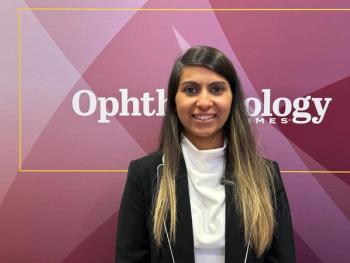
Surgical technique for facial palsy provides good outcomes
Austin, TX-A new surgical technique addresses the cosmetic concerns of patients with facial palsy and provides them the eye protection that they need, said Sheri L. De Martel?re, MD, an oculoplastic surgeon in private practice in Austin, TX.
Austin, TX-A new surgical technique addresses the cosmetic concerns of patients with facial palsy and provides them the eye protection that they need, said Sheri L. De Martelaere, MD, an oculoplastic surgeon in private practice in Austin, TX.
For the past 50 years, lid loading procedures and tarsorrhaphies have been the primary techniques used in the care of patients with facial palsy, according to Dr. De Martelaere. Standard surgery involves placement of a large gold weight fixated low on the tarsus, a generous lateral tarsorrhaphy, or both.
Pretarsal eyelid tissue is thin, however, and gold weights placed low on the tarsus are subject to migration, extrusion, and infection. Patients may complain of an unsightly bulge in addition to lost peripheral vision from the tarsorrhaphy and asymmetry compared with the unaffected eye.
Procedure
This surgical technique was first performed, to their knowledge, by John W. Shore, MD, a partner in Dr. De Martelaere's practice, in 1990. It involves placement of a small gold weight high in the eyelid combined with a recession of the levator aponeurosis. Lower eyelid lagophthalmos is corrected with a tongue-in-groove lateral tarsorrhaphy and lower eyelid tightening if necessary.
Next, an incision is made in the upper eyelid crease, the orbicularis and the orbital septum are divided, and the levator aponeurosis is exposed. The levator is disinserted from the upper quarter of the tarsus and recessed approximately 2 mm.
The gold weight is used as a spacer by placing it between the upper tarsal border and the edge of the levator aponeurosis; 7-0 silk is used to suture the gold weight to the superior edge of tarsus inferiorly and the leading edge of the levator superiorly. The preaponeurotic fat, if present, is then draped over the gold weight.
Attention is then directed to the lower eyelid, where, following canthotomy and inferior cantholysis, a lateral tarsal strip is developed. The lateral upper eyelid is split along the gray line. Dissection continues superiorly between the orbicularis and the anterior tarsal surface, creating a pocket.
A double-armed 5-0 polypropylene (Prolene, Ethicon Inc.) suture is passed through the edge of the tarsal strip, then into the pocket created in the upper eyelid, with the needles passing through periosteum at the arcus marginalis. The suture is externalized and secured over a bolster; the upper eyelid muscle and skin are then closed.
Postop assessment
Patients were assessed postoperatively to follow the status of their corneal epithelium and surgical healing. They were followed for 1 to 71 months, with an average of 18 months. The mean gold weight mass was 1.2 g. All patients had a gold weight placed, and 83% also had a tongue-in-groove lateral tarsorrhaphy. There were no cosmetic complaints, and no extrusions, migrations, or infections. Ninety-eight percent of patients experienced improvement of their corneal epitheliopathy.
"Although cosmesis is highly subjective, our patients were uniformly pleased with their surgical outcomes," Dr. De Martelaere said. "There was minimal ptosis postoperatively and good symmetry with the other eye. Patients had good eyelid closure and experienced no increase in nocturnal exposure problems."
One patient had an additional direct browlift and is doing well 2 years postoperatively. In all, slightly more than half of the patients underwent additional procedures, with the most frequent being excision of lower eyelid retractors and direct browlifting.
"Overall, the advantage of this technique is a reduction in the visual profile of the implant," Dr. De Martelaere said. "The location of the implant, increased tissue coverage, and the smaller gold weight mass have resulted in no extrusions, migrations, or infections to date. Our technique maintains good corneal protection and good peripheral vision for the patient."
If seventh-nerve function returns, then reversal is straightforward with excellent cosmetic results, she added. In this series, 12% of patients have undergone reversal and removal of the gold weight along with advancement of the levator aponeurosis back to the superior border of tarsus.
Newsletter
Don’t miss out—get Ophthalmology Times updates on the latest clinical advancements and expert interviews, straight to your inbox.













































.png)


